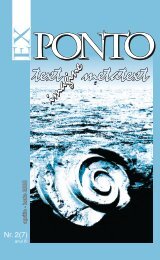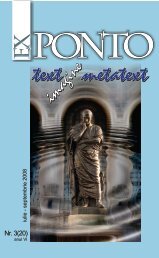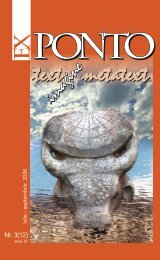Nr. 3 (24) anul VII / iulie-septembrie 2009 - ROMDIDAC
Nr. 3 (24) anul VII / iulie-septembrie 2009 - ROMDIDAC
Nr. 3 (24) anul VII / iulie-septembrie 2009 - ROMDIDAC
Create successful ePaper yourself
Turn your PDF publications into a flip-book with our unique Google optimized e-Paper software.
EX PONTO NR.3, <strong>2009</strong><br />
160<br />
part through the entire movie and that spectators were forced to experience<br />
the inconvenient position of the collaborator and to witness a drama which<br />
otherwise they would have chosen not to see.<br />
The Death of Mr. Lazarescu: Another Kind of Docu-drama<br />
Cristi Puiu’s film preceded 4 Months by less than two years. It was closer<br />
to a documentary than Mungiu’s film because of the explicit recurrence of<br />
“consistent patterns of behavior” (Ellis 14). As in any classic “naturalistic”<br />
documentary, 7 Puiu is interested in documenting what is specific for the<br />
daily rituals of his “subjects.” Lazarescu is talking to his cats, and having<br />
a shot of homemade brandy a couple of times a day while his neighbors<br />
are continuously contradicting each other, the husband always winning the<br />
arguments, the wife always giving in submissively. In the public sphere, rituals<br />
are not necessarily different: the ER doctors in four hospitals of Bucharest<br />
are aggressively asserting their professional superiority in front of nurses<br />
and patients alike. Furthermore, on the night when Lazarescu needs their<br />
help most, they are overwhelmed by the number of victims coming from a<br />
bus accident. The victims themselves are Romanians traveling by coach to<br />
Europe in search of a menial job. All are typical for Romanian society. The<br />
language clichés, the gestures, and the attitudes are recorded with the care<br />
of the ethnographer.<br />
For achieving the appearance of a rudimentary documentary, Puiu casts<br />
his actor friends, who were completely unknown at that time, in the major<br />
roles, and casts stars in episodic ones. The latter remain unnoticed even to a<br />
Romanian audience who would not have expected them in such minor parts.<br />
Without minimizing the actors’ contribution to their characters, it seems that the<br />
cast of the film was selected in conformity with extra-artistic criteria, perhaps<br />
financial and personal. Thus, Ion Fiscuteanu got the role of Mr Lazarescu<br />
Dante Remus (a 62 year-old retired engineer, originally from Tirgu-Mures<br />
(Transilvania), who lives and dies in Bucharest) because of his standard low<br />
fee as a supporting actor and more importantly, because of his Transilvanian<br />
descent. Born in Bistrita Nasaud, he was an authentic native speaker of the<br />
Transilvanian dialect, not to mention his having had the personal experience<br />
of suffering from a terminal illness which caused his real death the very next<br />
year.<br />
Unlike Mungiu’s “reconstruction of the event,” which was meant to suggest<br />
the Romanians’ guilt and resentfulness about communism, Puiu’s film has<br />
“no conventional dramaturgical progression from exposition to complication<br />
to discovery to climax to denouement” (Ellis 2) for the same reason. The lack<br />
of any narrative thread suggests the lack of coherence of Romanian society<br />
which could not cleanse itself and recover from the communist mentality.<br />
The camera is recording the catabasis of Mr Lazarescu (possibly an allegory<br />
of the Romanian old world) in the darkness of the Underworld, the unseen<br />
world behind the closed doors of the ambulance, the emergency room, and<br />
surgery unit. It violates the privacy of the suffering individual in each station<br />
of the labyrinthine wandering in the night in Bucharest hospitals, following Mr<br />
Lazarescu’s descent to the Underworld to confront the ultimate revelation that<br />
there is no mystery of life and death. The recurrent images from above the<br />
protagonist who lies in his bed, the hospital bed, the ambulance stretcher, and<br />
who gets down the stairs, gets out of the car, create the symbolic perspective<br />
of a looking down on Romanian life. The Romanians’ life is the Hell from which
















